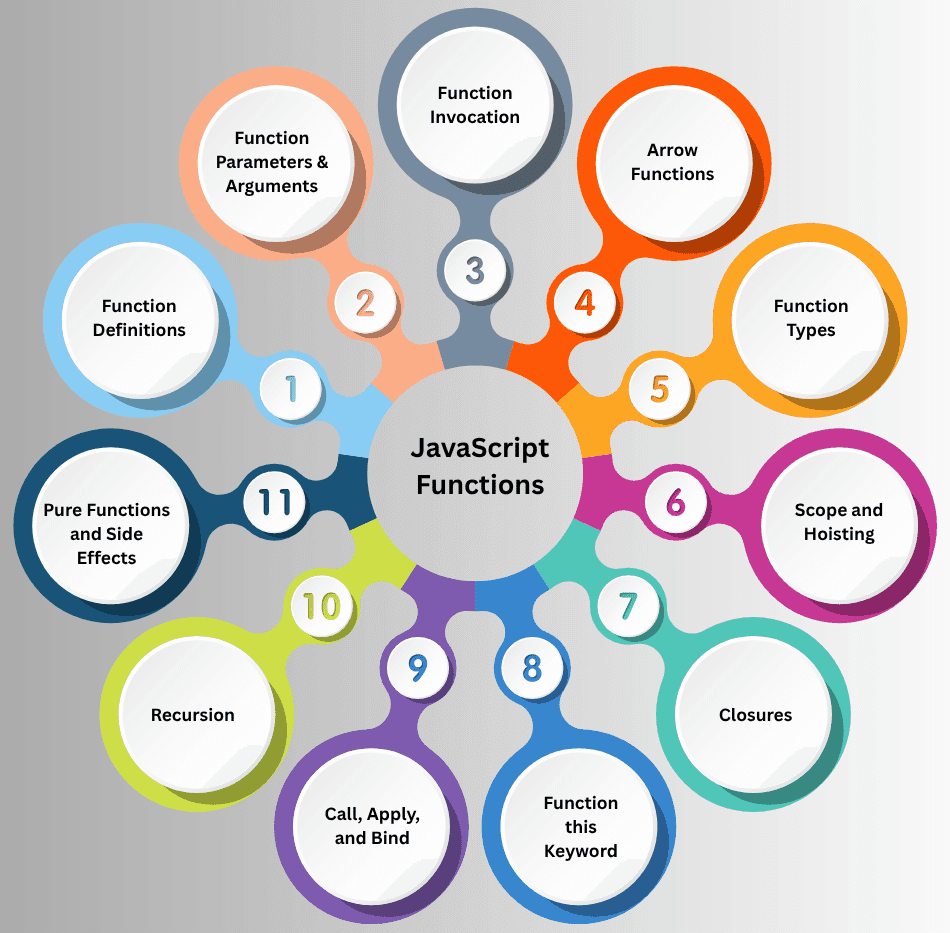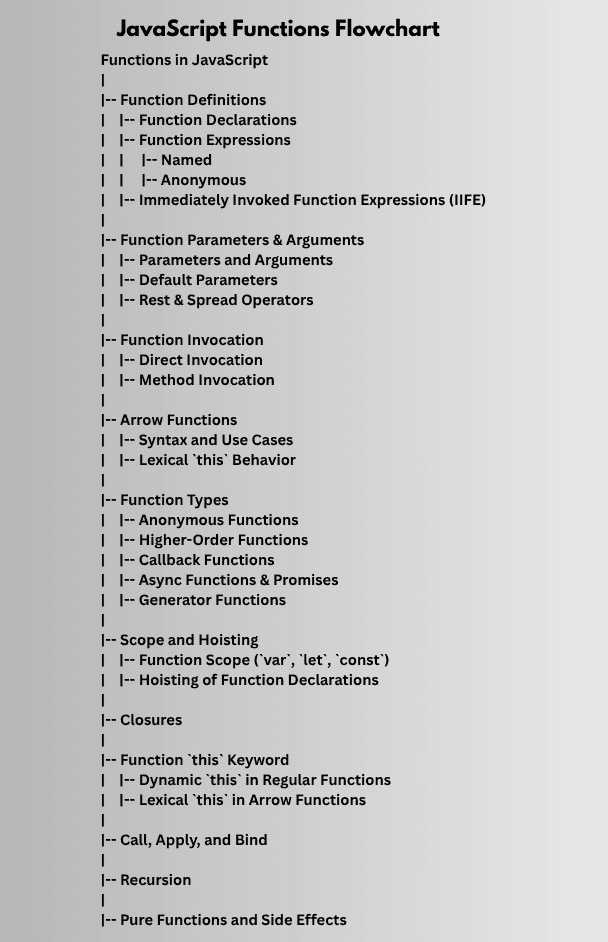Functions in JavaScript Overview
Functions are one of the core building blocks in JavaScript. They allow you to group code into reusable blocks, perform calculations, handle events, and manage complex logic efficiently.
JavaScript Function:
A function is a block of code designed to perform a specific task. Functions can:
- Accept input values called parameters.
- Perform operations on those inputs.
- Optionally return a value.
Functions help make code modular, reusable, and easier to maintain.
Why Functions are Important in JavaScript
- Enable code reuse.
- Improve readability and modularity.
- Essential for callbacks, event handling, async operations, and functional programming.
- Foundation for modern JavaScript frameworks like React, Angular, and Node.js.

1. Function Definitions
Function Declarations
A standard way to define a function using the function keyword.
function greet(name) {
return `Hello, ${name}!`;
}
console.log(greet("Alice")); // "Hello, Alice!"
Function Expressions
A function can be assigned to a variable. These can be named or anonymous.
// Anonymous function
const greet = function(name) {
return `Hello, ${name}!`;
};
// Named function expression
const greetNamed = function greetFunction(name) {
return `Hello, ${name}!`;
};
Immediately Invoked Function Expressions (IIFE)
Functions that execute immediately after creation.
(function() {
console.log("This runs immediately!");
})();
2. Function Parameters & Arguments
Parameters and Arguments
- Parameters: Variables defined in a function declaration.
- Arguments: Values passed to the function when called.
function add(a, b) {
return a + b;
}
console.log(add(5, 10)); // 15
Default Parameters
Set default values for parameters if no argument is passed.
function greet(name = "Guest") {
return `Hello, ${name}!`;
}
console.log(greet()); // "Hello, Guest!"
Rest & Spread Operators
- Rest (
...) collects multiple arguments into an array. - Spread (
...) expands arrays into individual elements.
function sum(...numbers) {
return numbers.reduce((total, num) => total + num, 0);
}
console.log(sum(1, 2, 3, 4)); // 10
const nums = [1, 2, 3];
console.log(Math.max(...nums)); // 3
3. Function Invocation
Direct Invocation
Calling a function directly by its name:
function greet() {
console.log("Hello!");
}
greet(); // "Hello!"
Method Invocation
Calling a function as a property of an object:
const user = {
name: "Alice",
greet: function() {
console.log(`Hello, ${this.name}!`);
}
};
user.greet(); // "Hello, Alice!"
4. Arrow Functions
Syntax and Use Cases
Arrow functions provide a shorter syntax for defining functions.
const greet = (name) => `Hello, ${name}!`;
console.log(greet("Alice")); // "Hello, Alice!"
Lexical this Behavior
Arrow functions do not have their own this, they inherit it from the surrounding scope.
const obj = {
name: "Alice",
greet: function() {
const inner = () => console.log(this.name);
inner(); // "Alice"
}
};
obj.greet();
5. Function Types
- Anonymous Functions – Functions without a name.
- Higher-Order Functions – Functions that accept or return other functions.
- Callback Functions – Functions passed as arguments to another function.
- Async Functions and Promises – For asynchronous operations.
- Generator Functions – Functions that can pause execution and resume.
6. Scope and Hoisting
Function Scope
Variables declared inside a function are only accessible within that function.
function test() {
let x = 10;
console.log(x);
}
test();
console.log(x); // Error: x is not defined
Hoisting
-
Function declarations are hoisted and can be called before definition.
- Function expressions are not hoisted.
7. Closures
A closure occurs when a function remembers variables from its outer scope even after that scope has executed.
function outer() {
let count = 0;
return function inner() {
count++;
return count;
};
}
const counter = outer();
console.log(counter()); // 1
console.log(counter()); // 2
8. The this Keyword in Functions
Dynamic this in Regular Functions
Depends on how the function is called.
Lexical this in Arrow Functions
Arrow functions inherit this from the parent scope.
9. Call, Apply, and Bind
- call() – Invokes a function with a given
thisand arguments individually. - apply() – Invokes a function with a given
thisand arguments as an array. - bind() – Returns a new function with a permanently bound
this.
function greet(greeting) {
console.log(`${greeting}, ${this.name}`);
}
const user = { name: "Alice" };
greet.call(user, "Hello"); // "Hello, Alice"
10. Recursion
A function can call itself, directly or indirectly.
function factorial(n) {
if (n === 0) return 1;
return n * factorial(n - 1);
}
console.log(factorial(5)); // 120
11. Pure Functions and Side Effects
- Pure Functions: Return the same output for the same inputs and have no side effects.
- Impure Functions: May modify external state or rely on external variables.
function add(a, b) {
return a + b; // Pure
}JavaScript Functions Flowchart


